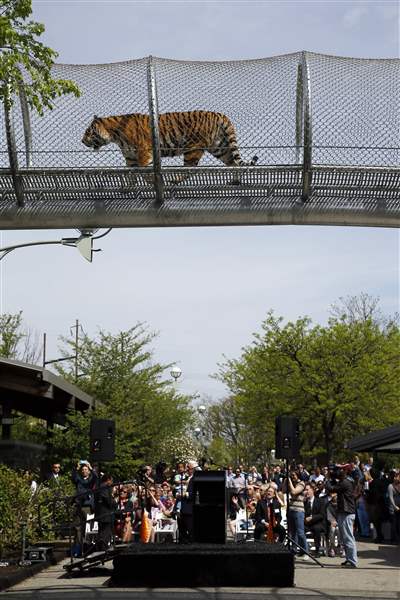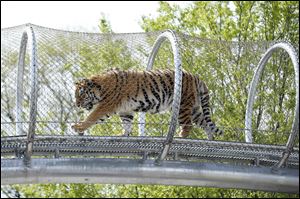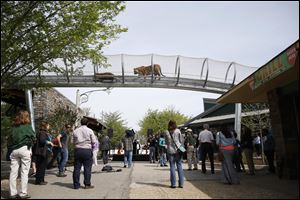
Philadelphia Zoo lets tigers stretch legs on trail
5/7/2014
An Amur tiger walks across a passageway after a news conference at the Philadelphia Zoo, Wednesday, May 7, 2014, in Philadelphia. The see-through mesh pathway called Big Cat Crossing is part of a national trend called animal rotation that zoos use to enrich the experience of both creatures and guests. (AP Photo/Matt Slocum)
ASSOCIATED PRESS

The see-through mesh pathway called Big Cat Crossing at the Philadelphia Zoo is part of a national trend called animal rotation that zoos use to enrich the experience of both creatures and guests.
PHILADELPHIA — Visitors to the Philadelphia Zoo might want to beware of stray cats: A new enclosed passageway allows lions and tigers to roam outside their exhibits.
Humans, though, can safely gawk at the predators traveling along Big Cat Crossing. The protected, open-air path snakes above the felines’ habitat to an archway over the zoo’s main promenade and ends at a viewing spot along a lake.
The concept for the catwalk unveiled today stems from the increasingly common practice of animal rotation, which lets animals take in new stimuli while visitors encounter them in unexpected places.
“It becomes much more of a safari-like experience,” said Philadelphia Zoo CEO Andrew Baker.
The $2.3 million project, paid for with state and private funds, is the latest addition to the zoo’s comprehensive travel system.
Within the past three years, it has opened a similar trail for small primates and another for orangutans. The trails system was primarily designed to improve animal well-being, but “we realized that there were huge opportunities from the guest experience side as well,” Baker said.
By that, Baker means that visitors might be challenged to track down animals that aren’t lolling around in their home habitats.
That could be fun for older kids, said Alexis Brookens, who visited the zoo Tuesday with a group including her 2-year-old daughter. But parents with younger children might prefer animals to stay in their assigned spaces, she said.
“I think it would be neat to see them walking around instead of just lounging,” said Brookens, of Bear, Delaware.

Amur tigers walk across a passageway after a news conference at the Philadelphia Zoo today.
Animal rotation has become more popular in the U.S. as “the public challenges zoos to improve,” said Ed Hansen, CEO of the American Association of Zoo Keepers.
Among the earliest efforts was the O Line at the National Zoo in Washington, which lets orangutans travel between enclosures by swinging from cables high above the property.
At the Denver Zoo, keepers rotate lions, African wild dogs and hyenas through a habitat. As the species alternate, the scents they leave behind stimulate the next occupants.
“It’s to replicate the natural environment as best as we can,” Hansen said. “It’s enriching to their environment and their mental capacity.”
In Philadelphia, the zoo has meshed those two concepts — travel and timeshare. Lions, tigers, pumas, jaguars and leopards already rotate among five exhibits. Now, they’ll take turns using Big Cat Crossing.
Today, brother Amur tigers Wiz and Dimitri wowed a crowd as they scampered along the trail, occasionally peering down at visitors.
The zoo plans eventually to extend and connect all three trails. So in the winter, when it’s too cold for orangutans to be outside, cats can use their trail, said Baker. Hooved animals like rhinos and giraffes also will get to travel.
Anecdotal evidence indicates animals are enjoying the trails and finding new stimuli, he said.
One species of monkey has been making territorial sounds that keepers typically don’t hear. Another small primate was once found on the trail watching a construction project that had captured his attention, Baker said.
On Tuesday, 5-year-old zoo visitor Noah Dzielak, of Wilmington, Delaware, said he likes the idea of a tiger being able to walk around.
“Because then he can see the zoo,” said Noah.